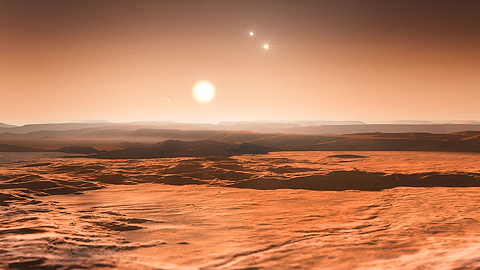Three Habitable Super-Earths Have Been Found
A team of astronomers, including Mikko Tuomi, researcher of the University of Turku, have found a first system of planets with a fully packed habitable zone. A record-breaking three of the planets are super-Earths lying in the zone around the star where liquid water could exist, making them possible candidates for the presence of life.

View from the surface of the planet Gliese 667Cd towards the Gliese 667C star (artist’s vision).
The astronomers combined new observations of a star Gliese 667C with existing data from HARPS (the High Accuracy Radial velocity Planet Searcher ) at ESO’s 3.6-metre telescope in Chile. They revealed a system with possibly up to seven planets.
The team was led by Mikko Tuomi, a researcher of the University of Turku, Finland, who is currently working at the University of Hertfordshire, UK and Guillem Anglada-Escudé of the University of Göttingen, Germany.
– Usually planets orbiting close to the Sun-like parent stars are very hot and unlikely to be habitable. Finding three low-mass planets in the star’s habitable zone is very exciting, Tuomi tells.
Within the Sun’s Neighbourhood
The Gliese 667C system is the first example of a system where such a low-mass star is seen to host several potentially rocky planets in the habitable zone.
Gliese 667C is a well-studied star. Just over one third of the mass of the Sun, it is part of a triple star system known as Gliese 667 (also referred to as GJ 667), 22 light-years away in the constellation of Scorpius (The Scorpion). This is quite close to us — within the Sun’s neighbourhood.
Previous studies of Gliese 667C had found that the star hosts three planets with one of them in the habitable zone. Now, a team of astronomers have reexamined the system by adding new HARPS observations and data from other telescopes to the already existing picture. They have found evidence for up to seven planets around the star.
These planets orbit the third fainter star of a triple star system. The two other suns would look like a pair of very bright stars visible in the daytime and at night they would provide as much illumination as the full Moon.
– These new results highlight how valuable it can be to re-analyse data in this way and combine results from different teams on different telescopes, says Anglada-Escudé.
Super-Earths Are More Massive that the Earth
Three of the planets are confirmed to be super-Earths — planets more massive than Earth, but less massive than planets like Uranus or Neptune — that are within their star’s habitable zone, a thin shell around a star in which water may be present in liquid form if conditions are right.
– This system consists of three super-Earths, two hot planets further in, and two cooler planets further out. The planets in the habitable zone and those closer to the star are expected to always have the same side facing the star, so that their day and year will be the same lengths, with one side in perpetual sunshine and the other always night, Tuomi reveals.
Gliese 667C is a cooler and dimmer star than many others. In this case the habitable zone lies entirely within an orbit the size of Mercury's, much closer in than the distance between the Earth and the Sun.
The new planets completely fill up the habitable zone of Gliese 667C, as there are no more stable orbits in which a planet could exist at the right distance to it.
ESO is the foremost intergovernmental astronomy organisation in Europe, which is supported by 15 countries including Finland.
More information
>> Description of HARPS
>> Photos of the La Silla Observatory
Text: HB
Photograph: ESO/M. Kornmesser